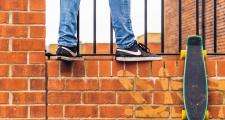Ban schools permanently excluding children who have a social worker

Published by Professional Social Work magazine, 4 October 2023
Care experienced children are three times more likely to be excluded from secondary school than their peers, damning new research has found.
Children with special education needs and those living in deprivation are also at significantly higher risk of being removed from school.
Authors of the research say a ban on schools permanently excluding children who have a social worker should now be considered.
The findings come as a new online resource to help families and professionals challenge school exclusions is launched.
Latest government figures show permanent exclusions shot up to 6,495 for the 2021/22 academic year compared to 3,928 the previous year.
School closures during Covid accounts for the dramatic rise. However, figures for the 2018/19 academic year before the pandemic show permanent exclusions at 7,900.
Temporary exclusions also went up from 352,454 in the 2020/21 academic year to 578,300 in 2021/22.
The research, from the University of Central London, shows 13 per cent of all children aged 11 to 16 were excluded at least once from secondary schools in England between 2011/12 and 2016/17. For care experienced children and those on child protection plans the proportion rises to 40 per cent.
For children in need, or formerly in need who have had social services involvement in their lives, the proportion is 32 per cent.
The research, based on an analysis of more than a million pupils, also found children on free school meals were more than twice as likely to be excluded – 26 per cent compared to 10.2 per cent.
For pupils living in the most deprived neighbourhoods on free school meals, the exclusion rate was 28 per cent compared to six per cent of pupils living in the least deprived areas not on free school meals.
For children with a history of special education needs in primary school, the proportion of exclusions was 21.3 per cent compared to 8.5 per cent for those without. For children who had been statemented or on an education, health and care plan the proportion excluded at secondary school was 22 per cent.
The study’s authors said the links between exposure to children’s social care, special education provision and school exclusion have implications for the commissioning of services.
“The use of exclusion against children looked after, those on child protection plans, and other children with a social worker, as well as those with SEN provision could additionally be limited in law to situations where it is absolutely necessary to protect the safety of that child or people around them, not simply as a disciplinary measure, and then only used for the shortest duration possible.”
They added: “Consideration could also be given to banning permanent exclusion altogether for these groups of children.”
Racial disparities were also highlighted in the study. Black children were the most likely to be excluded (22.2 per cent), followed by mixed race pupils (18.6 per cent), white (12.5 per cent) and Asian (ten per cent).
Boys were twice as likely to be excluded as girls (17.3 per cent compared to 8.5 per cent respectively).
Earlier this year, Westminster’s education select committee heard evidence of schools “off-rolling” pupils to boost exam results. The Local Government Association told MPs cuts to pastoral support due to budgetary pressures has made some schools more likely to permanently exclude.
In an effort to challenge the disproportionate exclusion of disadvantaged pupils, the School Exclusions Hub was launched last month.
It aims to provide information for families facing school exclusions and professionals who support them.
The site includes step-by-step guidance on the process and legal advice to help parents, carers and practitioners challenge school decisions.
The hub has been created by children’s rights charity Coram and is supported by Impact at Mission 44, a charity founded by Formula One racing driver Sir Lewis Hamilton to promote fairness and inclusion.
Coram’s chief executive Carol Homden said: “We have experienced significant and growing demand for our existing school exclusion resources. In launching this hub we aim for it to become a one-stop shop for all those who need legal support and advocacy in understanding school exclusion.”
Cara Cinnamon, director of Impact at Mission 44, said: “Together we will scale interventions that can address the disproportionate rate of school exclusions for young people from under-served communities.”
Meanwhile, concern has been raised of a school attendance crisis by MPs and children’s groups amid persistent absences currently running at twice the rate of before Covid.
More than a fifth of pupils in England were persistently missing from school in the last academic year compared to just over ten per cent before the pandemic.
For children on free school meals the figure was 37.9 per cent and for those with learning difficulties 33.4 per cent.
A report by Save the Children UK on behalf of the Children’s Rights Organisations published last month warned the impact of the pandemic on children “will be long-lasting and era-defining”.
It added children in poverty, from racial minorities and with special educational or mental health needs “suffered disproportionately, which highlighted existing inequalities in society”.
Authors of the report accused the government of failing to uphold the rights of children, saying: “It is our view that the Covid-19 pandemic disproportionately impacted children and young people because decision-makers did not consistently and robustly consider their rights and interests.”
